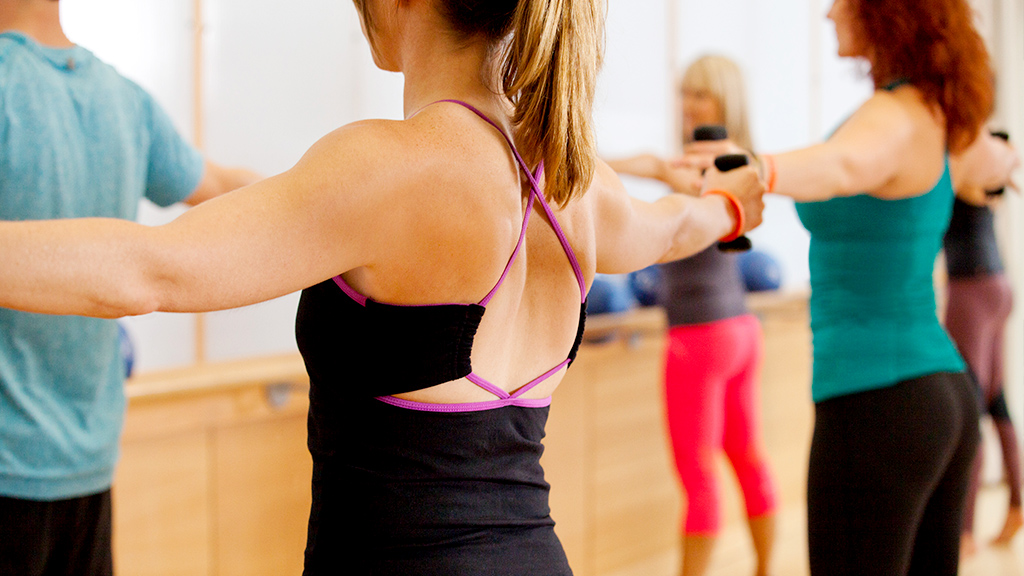Move
Modifications for Low-Back Pain
If you have lower back pain, you’re not alone. Back pain affects nearly 8 out of 10 people and is one of the most common medical problems in the United States. (Even founder Sadie Lincoln has worked through back issues; see below for two personal accounts of her experience).
The main root of all back pain is poor alignment and improper muscle recruitment. And it probably didn’t happen overnight—that’s because pain is usually the last symptom of a problem in your body, which means that your back was probably in stress mode for some time before it started to hurt.
At barre3, our focus is on balancing and strengthening the muscles that surround the back in a way that promotes prevention and healing. Every workout is designed to support the body in a neutral spine alignment, because that’s where your spine is the healthiest.
If your low back is acting up, there are plenty of ways you can modify your workout to eliminate pain, pressure or discomfort. Here are our top three recommendations:
1. Work higher.
In several postures where we hinge at the hips (like sumo squat), which ignites the back muscles to hold the upper body in a horizontal position. That’s great if you’re not having back pain—but if you are, we recommend working more upright to alleviate pressure on your back muscles and prevent them from going into spasm.
2. Take it slow.
When you move too fast, alignment starts to falter and improper muscle patterns start to take over instead of the proper chain of muscle execution. Not only can this exacerbate an old issue, it can create new ones. To keep your lower back happy, slow down and move with intention instead of momentum.
3. Find the right range of motion.
Everyone’s back pain is different—for some, moving in a large range of motion could feel best because it puts the muscle through contraction or release. But for structural issues like a bulging or herniated disc, moving large could put too much pressure on a localized area. If that’s the case, moving in a small range of motion, one inch from where it feels best, is the way to go. Listen to your body and work in a range of motion that matches your comfort and ability.
Some other great options for modifying include changing position and taking frequent breaks so you don’t overtax your back. Most importantly, ask for help when a posture doesn’t feel good. Your instructor will be happy to offer modifications that will protect your back while still providing an amazing workout. If you don’t have a studio nearby, feel free to reach out to us at onlinesupport@barre3.com with your questions or ask us now in the comments below!
Sadie’s Back Pain Blog Posts:
Is Fear Holding You Back?
I Got Your Back
If you are experiencing an issue with your back, please consult your doctor before doing any form of exercise.
If you have lower back pain, you’re not alone. Back pain affects nearly 8 out of 10 people and is one of the most common medical problems in the United States. (Even founder Sadie Lincoln has worked through back issues; see below for two personal accounts of her experience).
The main root of all back pain is poor alignment and improper muscle recruitment. And it probably didn’t happen overnight—that’s because pain is usually the last symptom of a problem in your body, which means that your back was probably in stress mode for some time before it started to hurt.
At barre3, our focus is on balancing and strengthening the muscles that surround the back in a way that promotes prevention and healing. Every workout is designed to support the body in a neutral spine alignment, because that’s where your spine is the healthiest.
If your low back is acting up, there are plenty of ways you can modify your workout to eliminate pain, pressure or discomfort. Here are our top three recommendations:
1. Work higher.
In several postures where we hinge at the hips (like sumo squat), which ignites the back muscles to hold the upper body in a horizontal position. That’s great if you’re not having back pain—but if you are, we recommend working more upright to alleviate pressure on your back muscles and prevent them from going into spasm.
2. Take it slow.
When you move too fast, alignment starts to falter and improper muscle patterns start to take over instead of the proper chain of muscle execution. Not only can this exacerbate an old issue, it can create new ones. To keep your lower back happy, slow down and move with intention instead of momentum.
3. Find the right range of motion.
Everyone’s back pain is different—for some, moving in a large range of motion could feel best because it puts the muscle through contraction or release. But for structural issues like a bulging or herniated disc, moving large could put too much pressure on a localized area. If that’s the case, moving in a small range of motion, one inch from where it feels best, is the way to go. Listen to your body and work in a range of motion that matches your comfort and ability.
Some other great options for modifying include changing position and taking frequent breaks so you don’t overtax your back. Most importantly, ask for help when a posture doesn’t feel good. Your instructor will be happy to offer modifications that will protect your back while still providing an amazing workout. If you don’t have a studio nearby, feel free to reach out to us at onlinesupport@barre3.com with your questions or ask us now in the comments below!
Sadie’s Back Pain Blog Posts:
Is Fear Holding You Back?
I Got Your Back
If you are experiencing an issue with your back, please consult your doctor before doing any form of exercise.










2 people have left a comment. Join the conversation!
View Comments